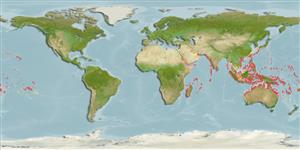Common names from other countries
>
Eupercaria/misc (Various families in series Eupercaria) >
Labridae (Wrasses) > Corinae
Etymology: Hemigymnus: Greek, hemi = half + Greek, gymnos = naked (Ref. 45335).
More on author: Bloch.
Environment: milieu / climate zone / depth range / distribution range
Ecologie
marien rifbewoner; diepte 0 - 25 m (Ref. 90102). Tropical; 30°N - 30°S, 33°E - 122°W
Indo-Pacific except the Red Sea.
Grootte / Gewicht / Leeftijd
Maturity: Lm ? range ? - ? cm
Max length : 30.0 cm TL mannelijk / geslacht onbekend; (Ref. 93095)
Dorsale stekels (totaal): 9; Dorsale zachte stralen (totaal): 10-11; Anale stekels 3; Anale zachte stralen: 11. Lips thick with age (Ref. 1623). Several color phases with age and sex (Ref. 48636). Basic color pattern changes little with growth although the posteriormost white bands disappear on large individuals (Ref. 1602).
Found mostly on coral reefs and reef flats to at least 20 m depth. Juveniles secretive on inshore reefs. Large adults swim openly on reefs, singly or in small loose aggregations (Ref. 48636). Adults feed mainly by taking mouthfuls of sand and gravel, releasing sand from the gill opening after sorting the small animal prey and ejecting the inorganic fragments from the mouth. Gut contents may contain shrimps and 25% the crushed remains of the echinoids Echinometra and Diadema, these were large prey; remaining food material consisted of very small gastopods, bivalves, crabs, ophiuroids, foraminiferans, and unidentified eggs (Ref. 93095). Feed mainly on small crustaceans, mollusks and echinoderms (Ref. 9823). Minimum depth reported taken from Ref. 128797.
Levenscyclus en paargedrag
Maturiteit | Voortplanting | Paaien | Eieren | Fecunditeit | Larven
Oviparous, with distinct pairing during breeding (Ref. 205).
Randall, J.E., 2013. Review of the Indo-Pacific labrid fish genus Hemigymnus. J. Ocean Sci. Found. 6:2-18. (Ref. 93095)
Status op de Rode Lijst van het IUCN (Ref. 130435)
CITES (Ref. 128078)
Not Evaluated
Gevaar voor de mens
Harmless
Gebruik door de mens
Visserij: van minder commercieel belang; Aquarium: Commercieel
Meer informatie
ReferentiesAquacultuurAquacultuurprofielKweeklijnenGeneticaElectrophoresesErfelijkheidZiektesVerwerkingMassaconversie
Tools
Speciale rapporten
Download XML
Internetbronnen
Estimates based on models
Preferred temperature (Ref.
115969): 24.9 - 29.3, mean 28.3 (based on 3355 cells).
Fylogenetische diversiteitsindex (Ref.
82804): PD
50 = 0.6250 [Uniqueness, from 0.5 = low to 2.0 = high].
Bayesian length-weight: a=0.00977 (0.00470 - 0.02030), b=3.07 (2.89 - 3.25), in cm Total Length, based on LWR estimates for this (Sub)family-body shape (Ref.
93245).
Trofisch niveau (Ref.
69278): 3.5 ±0.37 se; based on food items.
Weerstandsvermogen (Ref.
120179): Gemiddeld, minimale populatieverdubbelingstijd 1,4-4,4 jaar (Preliminary K or Fecundity.).
Fishing Vulnerability (Ref.
59153): Low vulnerability (20 of 100).
